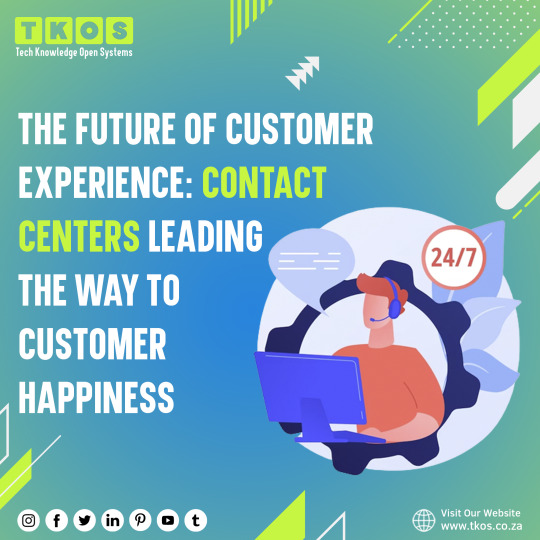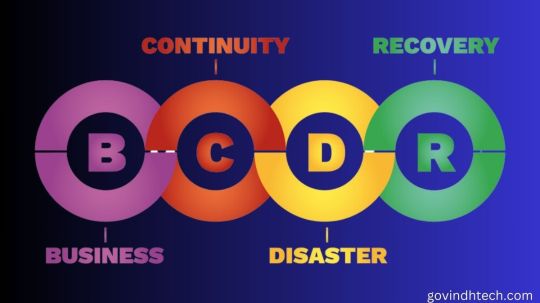#BusinessContinuity
Text
Smooth operations are the backbone of success. Our Application Development Services ensures your business runs seamlessly.
Here's why we're the trusted choice: https://briskwinit.com/application-development/
#ApplicationDevelopment#Maintenance#BusinessContinuity#TechSolutions#ITSupport#DigitalMaintenance#Reliability#ApplicationSupport#BusinessOperations#ApplicationManagement#TechServices
3 notes
·
View notes
Text

👉We provide franchises and convert your brands into franchise models😊
if you are interested in starting your own business or converting a franchise model into your brand👈
🤙contact me:-8447390992,9667389170
For more information visit our youtube channel
👇👇👇👇👇👇👇
https://youtu.be/q85mZoD8Vp4?feature=shared
🙏Thanks🙏
#youtube#growth#franchiseopportunity#franchise#marketing#lifecoach#opportunities#education#business coach#business consultant#businesscontinuity#business consulting services
3 notes
·
View notes
Text

The Future of CX: Contact Centers Leading the Way to Customer Happiness
Experience the future of CX with a top-notch Contact Center! Elevate customer satisfaction, embrace flexibility, and ensure business continuity.
For more information : https://www.tkos.co.za/contact-center/
Contact Us :
👉 Email:- [email protected]
👉 Call Us on:- +27 10 070 6000
#FutureofCX#ContactCenterExcellence#CustomerSatisfaction#FlexibilityInBusiness#BusinessContinuity#CustomerCentric#ElevateCX#ContactCenterSolutions#DigitalTransformation#FutureofCustomerCare
2 notes
·
View notes
Text
4 notes
·
View notes
Text
Creating a High-Value MSP Experience for Business Clients

In today’s fast-paced business environment, Managed Service Providers (MSPs) play a critical role in ensuring the smooth operation of IT infrastructure. To stand out in a competitive market, MSPs must create a high-value experience for their business clients. This involves more than just delivering technical services; it requires a strategic approach to customer relationship management, proactive problem-solving, and continuous improvement. Here’s how MSPs can create a high-value experience for their business clients.
1. Understand Client Needs and Goals
The foundation of a high-value MSP experience is a deep understanding of the client’s business needs and objectives. MSPs should engage in regular conversations with clients to understand their strategic goals, pain points, and specific requirements. This knowledge allows MSPs to tailor their services to meet the unique demands of each client, providing solutions that drive business success.
2. Offer Proactive and Predictive Support
High-value MSPs don’t wait for problems to occur; they anticipate issues and address them before they impact the client’s operations. Implementing advanced monitoring tools and predictive analytics can help MSPs identify potential threats and performance bottlenecks. By resolving issues proactively, MSPs minimize downtime and enhance the reliability of the client’s IT systems.
3. Deliver Exceptional Customer Service
Exceptional customer service is a key differentiator for MSPs. This includes providing timely and effective support, maintaining clear and transparent communication, and being responsive to client inquiries. MSPs should invest in training their support staff to be courteous, knowledgeable, and solution-oriented. A positive customer service experience builds trust and fosters long-term client relationships.
4. Provide Comprehensive Security Solutions
With the increasing frequency of cyber threats, security has become a top priority for businesses. MSPs must offer comprehensive security solutions, including robust firewall protection, regular security audits, employee training on cybersecurity best practices, and incident response planning. Demonstrating a commitment to security helps clients feel confident in their MSP’s ability to protect their sensitive data and systems.
5. Implement Customizable Service Plans
Clients have varying needs and budgets, so offering customizable service plans can enhance the perceived value of an MSP’s offerings. Flexible service plans allow clients to choose the level of support and services that best align with their business requirements and financial constraints. This customization fosters a sense of partnership and shows that the MSP is committed to meeting the client’s specific needs.
6. Focus on Continuous Improvement
The IT landscape is constantly evolving, and high-value MSPs must stay ahead of the curve. Regularly updating their knowledge base, adopting new technologies, and refining service delivery processes are essential. MSPs should seek client feedback and use it to make continuous improvements. Demonstrating a commitment to innovation and excellence ensures that clients receive the best possible service.
7. Build Strong Partnerships
Building strong partnerships with clients goes beyond providing technical services. MSPs should strive to be trusted advisors, offering insights and recommendations that contribute to the client’s overall business strategy. This might include advising on IT infrastructure investments, helping with digital transformation initiatives, or providing guidance on regulatory compliance.
8. Communicate the Value of Services
Clients need to understand the value they receive from their MSP. Regularly communicating the benefits of the services provided, through reports, meetings, and performance metrics, helps clients appreciate the MSP’s contributions to their business success. Clear communication about the ROI of MSP services reinforces the value proposition and strengthens the client-MSP relationship.
9. Foster a Culture of Accountability
Accountability is crucial for building trust. MSPs should set clear expectations, deliver on promises, and take responsibility for any shortcomings. A culture of accountability ensures that clients can rely on their MSP to be a dependable partner in managing their IT needs.
10. Invest in Long-Term Relationships
High-value MSPs view their client relationships as long-term partnerships. This perspective influences how they approach client interactions, support, and service delivery. Investing in long-term relationships involves consistently delivering high-quality services, being transparent about challenges and opportunities, and working collaboratively with clients to achieve their business goals.
Conclusion
Creating a high-value MSP experience for business clients requires a holistic approach that combines technical excellence with strategic partnership. By understanding client needs, offering proactive support, delivering exceptional customer service, and continuously improving their offerings, MSPs can build strong, lasting relationships with their clients. This not only enhances client satisfaction but also drives the MSP’s success in a competitive market.
0 notes
Text

Benefits of remote monitoring and notification capabilities in modern fire alarm systems
Remote monitoring and notification capabilities in modern fire alarm systems offer several benefits:
Early Detection: Remote monitoring allows for the detection of fire incidents as soon as they occur, even when there are no personnel present on-site. This early detection can significantly reduce response times and minimize damage.
24/7 Monitoring: With remote capabilities, fire alarm systems can be monitored around the clock, providing continuous protection against fire hazards. This ensures that any potential issues are identified and addressed promptly, regardless of the time of day.
Improved Safety: By promptly notifying designated personnel or emergency services about a fire incident, remote monitoring enhances overall safety for occupants and property. This rapid response can help evacuate individuals and mitigate risks before the situation escalates.
Reduced Downtime: Remote monitoring enables quick identification of system faults or malfunctions, allowing for timely maintenance and repairs. This proactive approach helps minimize system downtime, ensuring continuous protection against fire hazards.
Cost Savings: By preventing extensive fire damage through early detection and rapid response, remote monitoring can potentially save businesses significant costs associated with property damage, business interruption, and liability claims.
Compliance: Many regulatory standards and building codes require fire alarm systems to have remote monitoring capabilities. Implementing these features ensures compliance with safety regulations and standards, helping avoid fines and penalties.
Remote Access: Authorized personnel can remotely access the fire alarm system's status, alerts, and historical data from anywhere with an internet connection. This accessibility enhances convenience and allows for effective management of fire safety protocols.
Integration with Building Systems: Remote monitoring capabilities can be integrated with other building systems, such as HVAC and access control systems. This integration enables automated responses to fire alarms, such as HVAC shutdowns or unlocking doors for emergency egress.
Overall, remote monitoring and notification capabilities play a crucial role in enhancing the effectiveness, efficiency, and reliability of modern fire alarm systems, contributing to improved safety and protection for both people and property.
For, Fire Alarm Remote Monitoring Fire Alarm Houston would be a premium choice for your business.
#FireSafety#RemoteMonitoring#EarlyDetection#SafetyFirst#24/7Monitoring#EmergencyResponse#CostSavings#Compliance#BuildingSafety#Integration#SmartBuilding#ProactiveProtection#RiskMitigation#BusinessContinuity#EfficiencyBoost
1 note
·
View note
Text
"Key Principles of Cloud Security: Safeguarding Your Digital Assets in the Cloud"
Data Encryption: Encrypting data both at rest and in transit ensures that even if unauthorized individuals gain access to it, they won't be able to read or use it.
Access Control: Implementing strong access controls ensures that only authorized users can access sensitive data and resources within the cloud environment.
Identity and Authentication Management: Implementing robust identity and authentication mechanisms such as multi-factor authentication (MFA) helps verify the identity of users and prevents unauthorized access.
Network Security: Protecting the cloud environment with firewalls, intrusion detection and prevention systems, and network segmentation helps prevent unauthorized access and data breaches.
Compliance and Governance: Adhering to industry regulations and standards, as well as implementing comprehensive governance policies, helps ensure that the cloud environment remains secure and compliant with relevant requirements.
Regular Audits and Monitoring: Conducting regular audits and monitoring the cloud environment for suspicious activities helps detect and mitigate security threats in a timely manner.
Disaster Recovery and Business Continuity: Implementing robust disaster recovery and business continuity plans ensures that data and services can be quickly restored in the event of a security incident or disaster.
By following these principles, organizations can enhance the security of their cloud environments and mitigate the risks associated with cloud computing.
#CloudSecurity#DataEncryption#AccessControl#IdentityManagement#NetworkSecurity#Compliance#Governance#Auditing#DisasterRecovery#BusinessContinuity#magistersign#onlinetraining#support#cannada#usa
0 notes
Text
#ITInfrastructure#CloudServices#Cybersecurity#CloudSecurity#DataProtection#BusinessContinuity#EndpointSecurity#DataEncryption#BackupandRecovery#CloudBackup#CyberThreats#CloudSolutions#InformationSecurity#NetworkSecurity#ITSecurity#CloudComputing#DigitalTransformation#ITManagement#DataPrivacy#CloudMigration#ITStrategy#ITConsulting#TechSolutions
0 notes
Text

🔒 Keep your business running smoothly with ISO 22301 certification! B2BCert ensures your operations stay resilient and ready for any challenge. Get certified today for peace of mind and continued success! 💼✨
#ISO22301#BusinessContinuity#B2BCertResilience#DisasterRecovery#ISOStandards#CertifyWithConfidence#BusinessResilience#RiskManagement#SecureFuture#PrepareForSuccess#ISOCompliance#BusinessContinuityPlanning#B2BPreparedness#SafeguardOperations#BuildTrust
0 notes
Text
Elevate your business continuity with our top-notch Application Support and Maintenance services.
Here's why we're the trusted choice:https://briskwinit.com/application-support-and-maintenance/
Visit our website to explore how our Application Support & Maintenance keeps your digital journey glitch-free!
#BusinessContinuity#TechSupport#ApplicationSupport#MaintenanceSolutions#DigitalMaintenance#TechSolutions#Reliability#BusinessOperations#ApplicationManagement#ITSupport
3 notes
·
View notes
Text
Unlock precision through audits!
Is your data center a well-oiled machine, or harboring hidden inefficiencies? Are your smart buildings truly living up to their name? In today's ever-evolving technological landscape, thorough audits are more crucial than ever.

Unlock precision through audits! Cypress Solutions leads the way in Data Centre and Smart Building audits, ensuring safety, efficiency, and reliability. Discover the power of thorough assessments.
Ready to experience the power of #AuditsForExcellence? Contact Cypress Solutions today and schedule your personalized audit!
#AuditsForExcellence#CypressSolutions#DataCenter#SmartBuilding#DataSecurity#FacilityManagement#Sustainability#EnergyEfficiency#IoT#IIoT#Technology#PerformanceOptimization#BusinessContinuity#RiskManagement#Cybersecurity#CloudComputing#DigitalTransformation#FutureProof
0 notes
Text
Vendor Risk Management: Key Strategies
In today's interconnected and digital business landscape, vendor relationships are indispensable. From sourcing raw materials to outsourcing IT services, companies rely on a vast network of vendors to keep their operations running smoothly. However, this increased dependence on third-party vendors comes with its fair share of risks. This is where Vendor Risk Management (VRM) plays a pivotal role. In this blog, we will delve into the world of Vendor Risk Management, explore its significance, and learn how to navigate the intricate web of vendor relationships.
What is Vendor Risk Management?
Vendor Risk Management, often abbreviated as VRM, is a strategic discipline that enables organizations to assess, monitor, and mitigate the risks associated with their vendor partnerships. The primary goal is to protect an organization's data, finances, reputation, and operations by identifying and addressing vulnerabilities and potential threats within the vendor ecosystem.
Significance of Vendor Risk Management
Protecting Data: In an age when data breaches make headlines regularly, safeguarding sensitive information is paramount. Vendors often have access to a company's confidential data, making VRM essential in maintaining data security.
Regulatory Compliance: Many industries are governed by strict regulatory requirements, such as GDPR, HIPAA, or PCI DSS. Failure to comply can result in hefty fines and legal repercussions. VRM ensures that vendors adhere to these standards, reducing the risk of non-compliance.
Reputation Management: A vendor's misstep can tarnish an organization's reputation. Effective VRM helps maintain a company's reputation by ensuring that vendors adhere to ethical and professional standards.
Business Continuity: Vendor disruptions can bring a business to a standstill. VRM helps companies identify potential risks and develop strategies to ensure business continuity even in the face of vendor-related challenges.
Types of Vendor Risk Management
Financial Risk: Assess the financial stability of your vendors to ensure they can fulfill their obligations and not pose a risk to your supply chain.
Operational Risk: Evaluate the reliability and resilience of your vendors' operations. This includes assessing their disaster recovery plans and business continuity measures.
Cybersecurity Risk: Protect your data and systems by examining your vendors' cybersecurity practices. Ensure they have robust security measures in place to prevent data breaches.
Reputational Risk: Consider the reputation of your vendors and assess how their actions or missteps may impact your brand. Reputation management is crucial in VRM.
How Can Businesses Monitor and Manage Vendor Risk Management?
Vendor Risk Management (VRM) is a complex and ongoing process that requires businesses to be vigilant and proactive in assessing and mitigating risks. Market intelligence reports play a crucial role in this endeavor, offering valuable insights and information that can significantly enhance a company's VRM strategy. Here's how market intelligence reports are useful for monitoring and managing vendor risk:
1. Initial Vendor Assessment
Financial Health: Market intelligence reports provide in-depth financial analysis of potential vendors. This information helps businesses evaluate a vendor's financial stability and assess their ability to fulfill contractual obligations. It also helps identify vendors that might be at risk of financial instability, which could disrupt the supply chain.
Reputation and Track Record: These reports offer insights into a vendor's reputation, industry standing, and past performance. By examining vendor history and reputation, businesses can identify any red flags, such as past legal issues or customer complaints.
2. Risk Identification and Mitigation
Compliance and Regulatory Data: These reports include data on a vendor's adherence to industry regulations and standards. This information is critical for ensuring compliance with legal requirements and avoiding potential regulatory issues.
Market Trends and Industry Changes: Reports provide a comprehensive view of market trends and changes within the industry. This knowledge allows businesses to anticipate potential risks, adapt their strategies, and make informed decisions regarding vendor relationships.
3. Ongoing Monitoring
Continuous Vendor Evaluation: MI reports offer real-time or periodic updates on vendors. This ongoing monitoring helps businesses stay informed about any changes or issues that may affect the vendor's stability or reputation. It allows for timely adjustments to vendor portfolios as needed.
Alerts and Notifications: Some market intelligence platforms offer alerts and notifications related to specific vendors or industries. These alerts can signal changes in risk factors, allowing businesses to respond swiftly and effectively.
4. Informed Decision-Making
Data-Driven Decisions: The reports provide businesses with data and insights that support informed decision-making. Vendor Risk Management, 2022-2027, Worldwide reports help in vendor selection, contract negotiation, and adjustments to vendor relationships with greater confidence.
Risk Prioritization: By combining data from these reports with internal risk assessments, businesses can prioritize risks and allocate resources to address the most critical vulnerabilities within their vendor ecosystem.
Market intelligence reports are invaluable tools in the Vendor Risk Management process. Quadrant Knowledge Solution’s Vendor Risk Management, 2022, Worldwide reports provide vital information about potential and existing vendors, offering insights into various aspects of their operations, including financial stability, industry reputation, and regulatory compliance.
Best Practices in Vendor Risk Management
Clear Communication: Establish open channels of communication with your vendors to foster trust and transparency. Clearly define expectations and requirements in your contracts.
Regular Audits: Periodically assess vendor compliance with your agreed-upon standards. This may include security audits, financial reviews, or operational performance evaluations.
Data Security: Prioritize data security in vendor relationships. Ensure vendors have adequate measures in place to protect your data and establish protocols for data breach notification and response.
Escalation Procedures: Develop clear procedures for escalating issues with vendors. This ensures that problems are addressed in a timely and efficient manner.
Talk To Analyst
Conclusion
Vendor Risk Management is a critical aspect of modern business operations. By systematically assessing, monitoring, and mitigating the risks associated with vendor partnerships, organizations can safeguard their data, protect their reputation, and ensure business continuity. In an interconnected world, effective VRM is not just a best practice; it's a necessity. So, take the time to build a robust VRM program and navigate the intricate web of vendor relationships with confidence. Your business's future may depend on it. Utilizing market intelligence reports is a powerful tool in enhancing your VRM strategy and achieving success in the dynamic world of vendor relationships.
#VendorRiskManagement#VRM#BusinessSecurity#VendorRelationships#DataProtection#Cybersecurity#RiskMitigation#BusinessContinuity#MarketIntelligence#VendorAssessment#RiskPrioritization#DataSecurity
0 notes
Text
Business continuity vs disaster recovery plan steps

Business continuity vs disaster recovery
Which plan of action is most beneficial you, disaster restoration or business ongoing? Organisations use methods for risk control like continued operations and disaster recovery plans to ensure they are ready for unforeseen occurrences. While many of the phrases remain similar, there are actually several important differences to take into thought when deciding which is best for you.
The business continuous plan, or BCP, a is a comprehensive plan that explains how an establishment could return to regular operations in circumstances of a disaster. BCPs take a wide approach and seek to guarantee an organization can confront as broad a variety of risks as feasible, in contrast to other kinds of plans that could concentrate on one single component of recovery and interruption avoidance (such as a natural catastrophe or cybercrime).
Plan for disaster recovery (DRP): Disaster recovery plans, which are more comprehensive than business continuity plans (BCPs), include precise measures for how businesses will safeguard their IT systems and sensitive data in the event of a disruption. DR plans, in conjunction with BCPs, assist organizations in safeguarding their data and IT systems against a wide range of catastrophe scenarios, including ransomware and malware attacks, large-scale outages, and natural disasters.
Disaster recovery vs business continuity (BCDR): Depending on the requirements of the company, BCDR and business continuity may be handled together or independently. Executives are being asked to work jointly on BC and DR practices rather than alone as an increasing number of firms are shifting toward combined practice of the two disciplines. As a result, the two names were combined into one, BCDR, although the two practices’ fundamental meanings did not alter.
Irrespective of the strategy you use for BCDR development inside your company, it’s important to acknowledge the rapid global growth of this industry. Due to the rising costs associated with data loss and downtime resulting from poor BCDR, many businesses are increasing their current expenditures. According to a recent estimate by the International Data Corporation (IDC) (link lives outside ibm.com), businesses globally were expected to spend USD 219 billion on cybersecurity and solutions last year, a 12% rise from the year before.
What really makes disaster restoration and continuous operation strategies crucial?
Disaster recovery programs (DRPs) and business continuity programs (BCPs) assist firms in becoming ready for a variety of unforeseen events. A executed correctly disaster recovery plan may assist stakeholders in comprehending the potential hazards that a given threat may cause to normal company operations. Businesses that don’t engage in business continuity disaster recovery (BCDR) run the risk of unforeseen disasters causing data loss, downtime, financial fines, and reputational harm.
The following are some advantages that companies investing in disaster recovery and business continuity strategies might anticipate:
Reduced downtime: Businesses may have to spend hundreds of millions of dollars to reopen after a calamity that stops regular company operations. High-profile assaults are especially harmful because they often draw unwelcome attention, drive away investors, and drive consumers to rival companies that promise shorter outages. Irrespective of the kind of catastrophe you encounter, putting into practice a robust BCDR strategy can expedite your recovery period.
Reduced danger to the finances: IBM recently released its Cost of Data Breach Report, which shows that in 2023, the average cost of a data breach was USD 4.45 million, a 15% rise from 2020. Businesses who have robust business continuity strategies have shown that they may drastically lower such expenses by minimizing downtime and boosting investor and consumer trust.
Diminished fines: When confidential client information is disclosed, there may be severe consequences from data breaches. According to the significance of the data they regulate, corporations in the healthcare and household finance sectors are more vulnerable. Businesses operating in these areas need to have a solid business backup strategy in place to help lower the risk of facing severe financial fines.
Disaster recovery plan vs business continuity plan
Planning for business continuity and disaster recovery, or BCDR, works best when enterprises choose a distinct but integrated strategy. Disaster recovery plans (DRPs) and business continuity plans (BCPs) are similar, but they vary in a few key ways that make creating them independently beneficial:
Robust business continuity plans concentrate on strategies for maintaining regular business operations prior to, throughout, and right after a crisis.
DRPs are often more reactive, providing guidance on how to handle an event and resume normal operations.
Let’s take a quick look at a few terminology that are related to both BCPs and DRPs before getting into how to create successful ones:
The expression “recovery time objective,” or RTO, specifies how long it takes to resume company operations after an unanticipated event. One of the first steps firms should take when developing a BCP or DRP is establishing a suitable RTO.
Objective for recovery points (RPO): The quantity of data that your company can afford to lose in a catastrophe and still be able to recover is known as its recovery point goal, or RPO. Since many contemporary businesses consider data safety to be essential, some regularly replicate data to a different data center to guarantee continuity in the event of a significant breach. Others know they will be able to recover from whatever was lost during that period and set a reasonable RPO of a few minutes (or even hours) for business data to be restored from a backup system.
Read more on Govindhtech.com
#Businesscontinuity#disasterrecovery#InternationalDataCorporation#continuousoperation#disasterrestoration#technews#technology
0 notes
Text
Keeping your Business Flowing during a Global Pandemic
Amid the challenges of a global pandemic, discover how Microsoft Dynamics 365 offers a lifeline for businesses, enabling seamless remote work and robust connectivity. Explore the benefits of Dynamics 365 for maintaining productivity across departments, including secure credit card processing solutions to safeguard transactions in an increasingly digital landscape.
0 notes
Text
#BackupPlanning#BackupStrategies#BusinessContinuity#cybersecurity#DataIntegrity#dataprotection#DigitalAssets#DisasterRecovery#ITResilience#WebsiteBackups#gauravgo#gauravgo posts
0 notes
Text
Secure Your Data on the Go: A Guide to Responsible Remote Wiping on Mobile Devices

#DataSecurityExpert#MobileDeviceManagement#BusinessContinuity#CybersecurityAwareness#ITProTip#EmployeeTechGuide#BYODPolicy#RemoteWorkSolutions#RemoteWipe#MobileSecurity#DataProtection#LostPhone#StolenPhone#TechTips#SecurityGuide#Cybersecurity#BYOD#BusinessTech
0 notes